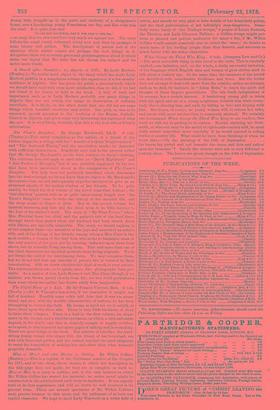The Vicar's Daughter. By George Macdonald, LL.D. 3 vols. (Tinsley.)—This
novel completes, as the author, or a friend of the author, suggests, a trilogy with the Annals of a Quiet Neighbourhood " and "The Seaboard Parish," and the association marks its character with sufficient distinctness. Somebody once said to the present writer that Mr. George Macdonald's novels were sermons in sheep's clothing. The criticism does not apply to such tales as "David Elginbrod " and "Alec Forbes of Howglen," but it was probably suggested by the two that have been mentioned above as the companions of The Vicar's Daughter. The lady doss not positively introduce whole discourses into the text—though we do not know that we object to Mr. Macdonald's discourses—but she not unfrequently stops her narrative to give us an abundant supply of the spoken wisdom of her friends. To b3 quite candid, we found the first volume of the novel somewhat tedious ; the introductory ' portion tolls us at quite unnecessary length how the Vicar's Daughter' came to write the history of her married life, and the story seems to linger a little. But in the second volume the interest increases, and this and the third seem to us little inferior to the best of the author's work. The story of "My First Terror," where Mrs. Percival loses her child, and the pathetic tale of the hard times through which they passed when the husband had been struck down with illness, are specially admirable. The story, we should explain, is of the simplest kind—the narrative of the joys and sorrows of an artist's wife, and of the doings of her friends, among whom a Miss Clare is the most notable, a woman of the very boat, who seeks to humanise some of the very poorest of the poor, not by exerting influence upon them from above, but by actually living among them. This and more than one of the chief characters are manifest portraits from living originals. We do not blame the author for introducing them. We may recognise them, but we do not feel that any sanctity of private life is violated by their introduction. Still we doubt whether this kind of work is very artistic. The representations are, so to speak, more like photographs than por- traits. As a matter of fact, Lady Bernard and Miss Clare, though, if we mistake not, drawn pretty closely from life, are less vivid portraitures than some whom the author has drawn solely from imagination.


































 Previous page
Previous page